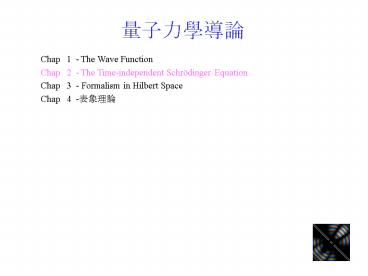Chap 1 The Wave Function - PowerPoint PPT Presentation
1 / 22
Title:
Chap 1 The Wave Function
Description:
??????. Chap 1 - The Wave Function. Chap 2 - The Time-independent Schr dinger Equation. Chap 3 - Formalism in Hilbert Space. Chap 4 -????. Quantum Mechanics ... – PowerPoint PPT presentation
Number of Views:325
Avg rating:3.0/5.0
Title: Chap 1 The Wave Function
1
??????
Chap 1 - The Wave Function Chap 2 - The
Time-independent Schrödinger Equation Chap 3 -
Formalism in Hilbert Space Chap 4 -????
2
Quantum Mechanics
Chap 2 - The Time-independent Schrödinger
Equation
? 2.1 Stationary state
Assume V is independent of t , use separation of
variables
Deduce from equation (2.1) , then
3
Quantum Mechanics
...(2.2)
time-independent Schrödinger equation
4
Quantum Mechanics
properties of
(i) Stationary state
for every expectation value
is constant in time
(ii) Definite total energy
Classical mechanics total energy is Hamiltonian
Quantum mechanics corresponding Hamiltonian
operator
5
Quantum Mechanics
thus equation (2.2)
6
Quantum Mechanics
(iii) Linear combination of separable solution
? 2.2 Infinite square well( one dimensional box)
and boundary conditions
7
Quantum Mechanics
deduce
outside the potential well ,
probability is zero for finding the particle
inside the well V 0
thus
8
Quantum Mechanics
normalize
9
Quantum Mechanics
first three states and probability density of
infinite square well
10
Quantum Mechanics
? 2.3 Harmonic oscillator
Classical treatment
solution
potential energy V is related to F
Quantum treatment
11
Quantum Mechanics
solve equation (2.3) by use ladder operator
rewrite equation (2.3) by ladder operator
12
Quantum Mechanics
compare equation(2.3)
similarly
discussion (i)
13
Quantum Mechanics
and
(ii)
and
14
Quantum Mechanics
and
(iii) there must exist a min state with
and from
15
Quantum Mechanics
and
so the ladder of stationary states can
illustrate
16
Quantum Mechanics
and
? 2.4 Delta-function potential
Energy E
Consider potential
then
17
Quantum Mechanics
(i) bound state E lt 0
similarly
use boundary condition
find k from
18
Quantum Mechanics
and
so
and
normalize
19
Quantum Mechanics
(ii) scattering state E gt 0
and
20
Quantum Mechanics
for wave coming in from left ( D 0 ) , equation
(2.5),(2.6) rewrite
is incident wave
is reflected wave
is transmitted wave
R is reflection coefficient
T is transmission coefficient
21
Quantum Mechanics
? 2.5 Free particle
22
Quantum Mechanics
Fourier transform
wave packet moves along at group velocity
and phase velocity
so
wave packet































